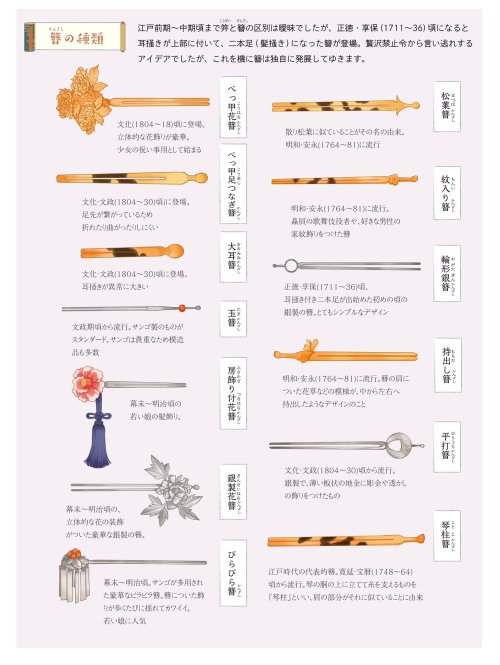tanuki-kimono: 簪 Kanzashi (Japanese hairpins) and いち止 Ichidome (hairstops), handy charts by Edo love
tanuki-kimono: 簪 Kanzashi (Japanese hairpins) and いち止 Ichidome (hairstops), handy charts by Edo lover Nadeshico Rin following the kushi/combs and kôgai/hairsticks ones.Technically, kôgai (hairsticks, rod-like/single prong) were pratical hair accessories meant to hold mage (chignon), where kanzashi (hairpins, with 2 prongs) were used as decorations only.Historically, two prongs hairpins differentiated from kôgai to circle around sumptuary laws* banning certain types/material for kôgai. (*I remember reading that kôgai could be used as weapons which probably weighted in the authorities’ decision to ban some kôgai types ^^;)Nowadays in the West, word “kanzashi” often refers to “tsumami kanzashi” ie hairpins with silk flowers. But many types existed, many of which are now mostly seen worn in “traditional”/formal settings (tea ceremony, wedding, or by Geisha/Maiko for example). As for hairpins types, you can see here from right to left, top to bottom (pins are more or less sorted chronologically):Right column:松葉簪 - matsuba kanzashi (pine needle hairpin) - straight forward name for this pin which looks like a big pine needle, it was popular during Meiwa and An’ei eras紋入り簪 - mon iri kanzashi (crest hairpin) - popular during Meiwa/An’ei eras, this pin had a small crest carved between tab and prongs parts. Women could wear their family crest, but also their favourite Kabuki actors one’s for ex for historical fangirling ;)輪形銀簪 - wagata gin kanzashi (ring shaped silver hairpin) - a simple yet refined pin which appeared around Shôtoku/Kyôhô eras. Apparently one of the first hairpins having two prongs + tab design持出し簪 - mochidashi kanzashi (stick out pattern hairpin) - once again a popular Meiwa/An’ei eras pin, with carved flowery motifs sticking out 平打簪 - hirauchi kanzashi (flat crest hairpin) - another well known metal pin (still seen nowadays though crest part is often smaller) which appeared around Bunka/Bunsei eras. It has a flat tab shaped as crest, which can be stamped, carved or cut out琴柱簪 - kotoji kanzashi (koto bridge hairpin) - the typical “Edo era” hairpin, popular since Kan’en/Hôreki eras. The elegant name is pretty straight forward as it does look like an elongated koto bridgeLeft column: べつ甲花簪 - bekkô hana kanzashi (turtle shell flowers hairpin) - a striking style which appeared in Bunka era. It was first worn by (rich) young ladies for formal/celebratory events. It is now only worn by brides on their wedding day.べつ甲足つなぎ簪 - bekkô ashitsunagi kanzashi (turtle shell linked prongs hairpin) - a sturdy pin thanks to its connected ends, it first appeared during Bunka/Bunsei eras.大耳簪 - ômimi kanzashi (big ear hairpin) - also appeared during Bunka/Bunsei eras, the telling name comes from its large tab.Edo people used the top part of hairpins (the ‘ear’/tab) to clean wax from their ears (using them much like ear pick/ear spoons) so this could explain the name of this pin - too big to be actually used for this purposed. 玉簪 - tama kanzashi (beaded hairpin) - a pin which appeared in Bunsei era and remained steadily popular through the ages and well into nowadays. The bead was usually made from sango/coral, but many variations existed (like jade for ex, but also cheaper materials like died horn, glass, celluloid etc).房飾り付花簪 - fusakazari tsukihana kanzashi (tasseled flower hairpin) - a big pin with cute fluttering ornament worn by young girls from late Edo to Meiji era.銀製花簪 - ginsei hana kanzashi (silver flower hairpin) - gorgeous flowery hairpin made from costly silver, popular from late Edo to Meiji era. Rin doesn’t say anything about it, but I don’t think this could have been anything but a special ornament for formal wear ^^びらびら簪 - birabira kanzashi (dangling hairpin) - a style well known by Maiko fans! Those fluttering metal pins were popular during late Edo and Meiji era, especially among “musume” (unmaried women, especially refering to fashionable city girls). The beads here are coral ones Ichidome note - ichidome are small hairpins meant to hold (dome) into place the “tail” (ichi) part of some nihongami hairstyles:笄タイプ - kôgai type also known 髷どめ wagedome (”chignon stop”) - those pins were used from late Edo to begining of Meiji. They were especially fashionable in Kyoto/Osaka, among girls who wore them with sakkô hairstyle (an hairdo now seen on maiko during their erikae)ピンタイプ - pin type - if kôgai types were used in Kansai, if I understand Rin currectly, Edo (Tokyo) fashionistas prefered to wear only one part of the kôgai pinned into their hair - which then lead to those small pins designs -- source link
Tumblr Blog : tanuki-kimono.tumblr.com

